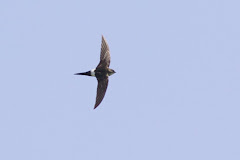A cycle ride to Amager today produced some quality winter birds. First, a staggering 110 SMEW (a large percentage were stunning drakes) were split into 3 or 4 loose flocks on the narrow sea channel between Amager and Sjaelland. These were accompanied by around 40 GOOSANDER, a handful of RED-BREASTED MERGANSER, a single GREATER SCAUP and a few WIGEON. The only Grebes in evidence were around 50 LITTLE GREBES.
A bit further along the path, I scanned a group of loafing gulls and there was an adult COMMON GULL with a colour-ring on its right leg. I was able to read the letter/number combination so I have reported it to the BTO (British Trust for Ornithology) via their very useful website. Hopefully I will receive information about this bird within a few days that will tell me where and when it was ringed. Colour-ringing is an increasingly used method of tracking birds. Rings can vary from a large-ish colour ring with a letter/number combination that can easily be viewed in the field with binoculars or a telescope (most suited to relatively large birds) to a combination of smaller blank rings, often used in specific combinations on one or sometimes both legs. Colour-ringing allows birds to be recorded in the field which results in many more reports of ringed birds than the traditional small metal ring that requires either a re-trapping of the bird, or the find of a corpse, to retrieve any data about a bird's movements. The bird I saw today had a large red ring on its right leg with "M84" written in large white characters. It's probably been ringed fairly locally but, you never know, it could have come from Russia, the UK or even further afield. We shall see!
Finally, the highlight was an adult WHITE-TAILED EAGLE that came in fast and low over a flock of BARNACLE GEESE that I was watching - the geese were spooked and took to the air with an awful stressed honking sound but luckily for them the eagle seemed to be just wanting to sit where the geese had been feeding - it sat on a small rock and preened itself, accompanied by the attentions of the local Hooded Crows.
Saturday, 24 January 2009
Monday, 19 January 2009
You twit(e)s


Well, thank you to all 3 of you (mum, dad and my brother?) for voting in the poll... Either nobody is reading my blog (most likely explanation) or you all have better things to do than vote in a crumby bird quiz on the internet..!
In any case nobody got it right. The bird is a TWITE. These are northern birds that breed at high elevations in northern and western Scotland, northern England, Scandinavia and elsewhere with mountain ranges (Turkey, Caucasus etc). They come down to sea level in winter to feed, usually on coastal salt-marshes or dunes systems. Very much like a LINNET, its much commoner relative, but with generally whiter underparts, a yellow bill in winter, an unmarked throat and a buffy-orange face (as opposed to a greyish face in Linnet). The tail of the Twite is also longer and more deeply forked. Perhaps the most obvious difference, although sometimes difficult to see, is the pink rump of adult Twite. This can be frustratingly difficult to see, with the rump often covered by wing feathers, but it is a diagnostic feature. In Denmark these birds are winter visitors, usually in small to medium sized flocks along the northern and eastern coasts.
The photos above are of two different individials in the same flock.
Friday, 2 January 2009
Mystery Bird Competition

2009 got off to a good start when I connected with the American Black Scoter that has been present on the north coast of Sjaelland for a few days. It is hanging about with a few Common Scoter and seems to be taking quite a bit of interest in one of the 'Common' females, even displaying at one point today... You can see a photo (not mine unfortunately) by clicking here. It was a bitterly cold night last night (apparently about -8 when I arrived at first light) with a cold northerly breeze coming in off the sea. Six layers (including two 'down' jackets) and a pair of gloves approved for -30 degrees were enough to keep me snug.
After enjoying the scoter flock, I had a good look around the pine forest and dunes nearby. Plenty of Coal Tits, Goldcrests, a pair of Marsh Tits and a Treecreeper was my reward.
I also saw the bird in the photo above and thought I'd test you birders (and budding birders) by asking you for your opinion. Simply make your vote on the panel to the right of the screen and all will be revealed next week... (click the photo for a larger version).
Good luck!
Subscribe to:
Comments (Atom)





